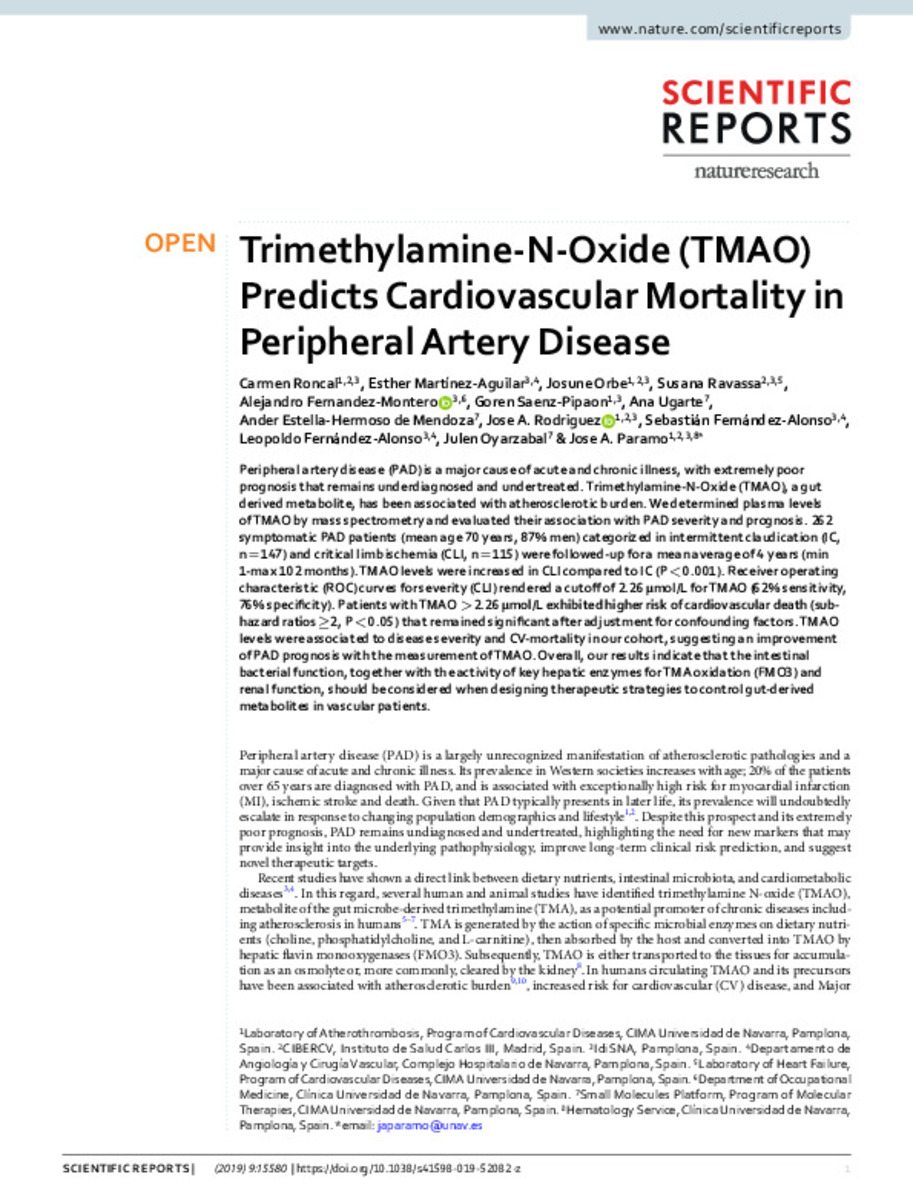Registro completo de metadatos
| Campo DC | Valor | Lengua/Idioma |
|---|---|---|
| dc.creator | Roncal, C. (Carmen) | - |
| dc.creator | Martínez-Aguilar, E. (Esther) | - |
| dc.creator | Orbe, J. (Josune) | - |
| dc.creator | Ravassa, S. (Susana) | - |
| dc.creator | Fernandez-Montero, A. (Alejandro) | - |
| dc.creator | Saenz-Pipaón, G. (Goren) | - |
| dc.creator | Ugarte, A. (Ana) | - |
| dc.creator | Estella-Hermoso-de-Mendoza, A. (Ander) | - |
| dc.creator | Rodriguez, J.A. (José Antonio) | - |
| dc.creator | Fernández-Alonso, S. (Sebastián) | - |
| dc.creator | Fernandez-Alonso, L. (Leopoldo) | - |
| dc.creator | Oyarzabal, J. (Julen) | - |
| dc.creator | Paramo, J.A. (José Antonio) | - |
| dc.date.accessioned | 2021-11-09T12:00:41Z | - |
| dc.date.available | 2021-11-09T12:00:41Z | - |
| dc.date.issued | 2019 | - |
| dc.identifier.citation | Roncal, C. (Carmen); Martínez-Aguilar, E. (Esther); Orbe, J. (Josune); et al. "Trimethylamine-N-Oxide (TMAO) Predicts Cardiovascular Mortality in Peripheral Artery Disease". Scientific Reports. 9 (15580), 2019, 1 - 8 | es |
| dc.identifier.issn | 2045-2322 | - |
| dc.identifier.other | PMID: 31666590 | - |
| dc.identifier.uri | https://hdl.handle.net/10171/62413 | - |
| dc.description.abstract | Peripheral artery disease (PAD) is a major cause of acute and chronic illness, with extremely poor prognosis that remains underdiagnosed and undertreated. Trimethylamine-N-Oxide (TMAO), a gut derived metabolite, has been associated with atherosclerotic burden. We determined plasma levels of TMAO by mass spectrometry and evaluated their association with PAD severity and prognosis. 262 symptomatic PAD patients (mean age 70 years, 87% men) categorized in intermittent claudication (IC, n = 147) and critical limb ischemia (CLI, n = 115) were followed-up for a mean average of 4 years (min 1-max 102 months). TMAO levels were increased in CLI compared to IC (P < 0.001). Receiver operating characteristic (ROC) curves for severity (CLI) rendered a cutoff of 2.26 µmol/L for TMAO (62% sensitivity, 76% specificity). Patients with TMAO > 2.26 µmol/L exhibited higher risk of cardiovascular death (sub-hazard ratios ≥2, P < 0.05) that remained significant after adjustment for confounding factors. TMAO levels were associated to disease severity and CV-mortality in our cohort, suggesting an improvement of PAD prognosis with the measurement of TMAO. Overall, our results indicate that the intestinal bacterial function, together with the activity of key hepatic enzymes for TMA oxidation (FMO3) and renal function, should be considered when designing therapeutic strategies to control gut-derived metabolites in vascular patients. | es_ES |
| dc.description.sponsorship | This work was supported by the Foundation for Applied Medical Research, Universidad de Navarra (Spain); European Fund for Economic and Regional Development (FEDER) funds [FIS PI18/01195], Ministry of Economy and Competitiveness, Institute of Health Carlos III, [CIBER-CV (CB16/11/00371)]. Patrimonio Praga (Mexico) and Virto Group (Spain). | es_ES |
| dc.language.iso | eng | es_ES |
| dc.publisher | Springer Science and Business Media LLC | es_ES |
| dc.rights | info:eu-repo/semantics/openAccess | es_ES |
| dc.subject | Materias Investigacion::Ciencias de la Salud::Cardiología | es_ES |
| dc.title | Trimethylamine-N-Oxide (TMAO) Predicts Cardiovascular Mortality in Peripheral Artery Disease | es_ES |
| dc.type | info:eu-repo/semantics/article | es_ES |
| dc.description.note | This article is licensed under a Creative Commons Attribution 4.0 International License, which permits use, sharing, adaptation, distribution and reproduction in any medium or format, as long as you give appropriate credit to the original author(s) and the source, provide a link to the Creative Commons license, and indicate if changes were made | es_ES |
| dc.identifier.doi | 10.1038/s41598-019-52082-z | - |
| dadun.citation.endingPage | 8 | es_ES |
| dadun.citation.number | 15580 | es_ES |
| dadun.citation.publicationName | Scientific Reports | es_ES |
| dadun.citation.startingPage | 1 | es_ES |
| dadun.citation.volume | 9 | es_ES |
Ficheros en este ítem:
Estadísticas e impacto
Los ítems de Dadun están protegidos por copyright, con todos los derechos reservados, a menos que se indique lo contrario.






